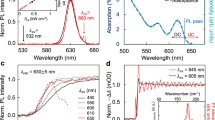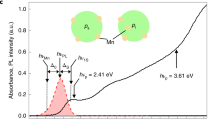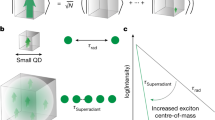Abstract
We have previously demonstrated that absorption of a single photon by a nanocrystal quantum dot can generate multiple excitons with an efficiency of up to 100%. This effect, known as carrier multiplication, should lead to substantial improvements in the performance of a variety of optoelectronic and photocatalytic devices, including solar cells, low-threshold lasers and entangled photon sources. Here we present detailed analysis of the dynamics that govern the ultrafast growth of multi-exciton populations in CdSe and PbSe nanocrystals and propose a model of how such populations arise. Our analysis indicates that the generation of multi-excitons in these systems takes less than 200 fs, which suggests that it is an instantaneous event. We explain this in terms of their direct photogeneration via multiple virtual single-exciton states. This process relies on both the confinement-enhanced Coulomb coupling between single excitons and multi-excitons and the large spectral density of high-energy single- and multi-exciton resonances that occur in semiconductor nanocrystals.
This is a preview of subscription content, access via your institution
Access options
Subscribe to this journal
Receive 12 print issues and online access
$209.00 per year
only $17.42 per issue
Buy this article
- Purchase on Springer Link
- Instant access to full article PDF
Prices may be subject to local taxes which are calculated during checkout




Similar content being viewed by others
References
Yu, G., Gao, J., Hummelen, J. C., Wudl, F. & Heeger, A. J. Polymer photovoltaic cells: Enhanced efficiencies via a network of internal donor-acceptor heterojunctions. Science 270, 1789–1791 (1995).
Grätzel, M. Photoelectrochemical cells. Nature 414, 338–344 (2001).
Landsberg, P. T., Nussbaumer, H. & Willeke, G. Band-band impact ionization and solar cell efficiency. J. Appl. Phys. 74, 1451–1452 (1993).
Kolodinski, S., Werner, J. H., Wittchen, T. & Queisser, H. J. Quantum efficiencies exceeding unity due to impact ionization in silicon solar cells. Appl. Phys. Lett. 63, 2405–2407 (1993).
Spirkl, W. & Ries, H. Luminescence and efficiency of an ideal photovoltaic cell with charge carrier multiplication. Phys. Rev. B 52, 11319–11325 (1995).
Nozik, A. J. Quantum dot solar cells. Physica E 14, 115–120 (2002).
Califano, M., Zunger, A. & Franceschetti, A. Direct carrier multiplication due to inverse Auger scattering in CdSe quantum dots. Appl. Phys. Lett. 84, 2409–2411 (2004).
Wolf, M., Brendel, R., Werner, J. H. & Queisser, H. J. Solar cell efficiency and carrier multiplication in Si1−xGe alloys. J. Appl. Phys. 83, 4213–4221 (1998).
Schaller, R. D. & Klimov, V. I. High efficiency carrier multiplication in PbSe nanocrystals: Implications for solar energy conversion. Phys. Rev. Lett. 92, 186601 (2004).
Ellingson, R. et al. Highly efficient multiple exciton generation in colloidal PbSe and PbS quantum dots. Nano Lett. 5, 865–871 (2005).
Schaller, R. D., Petruska, M. A. & Klimov, V. I. The effect of electronic structure on carrier multiplication efficiency: A comparative study of PbSe and CdSe nanocrystals. Appl. Phys. Lett.(in the press).
Murray, C. B., Norris, D. J. & Bawendi, M. G. Synthesis and characterization of nearly monodisperse CdE (E=S,Se,Te) semiconductor nanocrystallites. J. Am. Chem. Soc. 115, 8706–8715 (1993).
Murray, C. B. et al. Colloidal synthesis of nanocrystals and nanocrystal superlattices. IBM J. Res. Dev. 45, 47–56 (2001).
Klimov, V. I. Optical nonlinearities and ultrafast carrier dynamics in semiconductor nanocrystals. J. Phys. Chem. B 104, 6112–6123 (2000).
Klimov, V. I. & McBranch, D. W. Femtosecond 1P-to-1S electron relaxation in strongly confined semiconductor nanocrystals. Phys. Rev. Lett. 80, 4028–4031 (1998).
Landsberg, P. T. Recombination in Semiconductors (Cambridge Univ. Press, Cambridge, 1991).
Klimov, V. I., Mikhailovsky, A. A., McBranch, D. W., Leatherdale, C. A. & Bawendi, M. G. Quantization of multiparticle Auger rates in semiconductor quantum dots. Science 287, 1011–1013 (2000).
Achermann, M., Hollingsworth, J. A. & Klimov, V. I. Multiexcitons confined within a subexcitonic volume: Spectroscopic and dynamical signatures of neutral and charged biexcitons in ultrasmall semiconductor nanocrystals. Phys. Rev. B 68, 245302 (2003).
Shionoya, H., Saito, H., Hanamura, E. & Akimoto, O. Anisotropic excitonic molecules in CdS and CdSe. Solid State Commun. 12, 223–226 (1973).
Htoon, H., Cox, P. J. & Klimov, V. I. Structure of excited-state transitions of individual semiconductor nanocrystals probed by photoluminescence excitation spectroscopy. Phys. Rev. Lett. 93, 187402 (2004).
Crooker, S. A., Barrick, T., Hollingsworth, J. A. & Klimov, V. I. Multiple temperature regimes of radiative decay in CdSe nanocrystal quantum dots: Intrinsic limits to the dark-exciton lifetime. Appl. Phys. Lett. 82, 2793–2795 (2003).
Wehrenberg, B. L., Wang, C. J. & Guyot-Sionnest, P. Interband and intraband optical studies of PbSe colloidal quantum dots. J. Phys. Chem. B 106, 10634–10640 (2002).
Du, H. et al. Optical properties of colloidal PbSe nanocrystals. Nano Lett. 2, 1321–1324 (2002).
Acknowledgements
This work was supported by the Chemical Sciences, Biosciences and Geosciences Division of the Office of Basic Energy Sciences, Office of Science, US Department of Energy and Los Alamos LDRD funds. R.D.S. is supported by a Frederick Reines Fellowship. We thank J. M. Pietryga and M. A. Petruska for fabrication of nanocrystal samples.
Author information
Authors and Affiliations
Corresponding author
Ethics declarations
Competing interests
The authors declare no competing financial interests.
Rights and permissions
About this article
Cite this article
Schaller, R., Agranovich, V. & Klimov, V. High-efficiency carrier multiplication through direct photogeneration of multi-excitons via virtual single-exciton states. Nature Phys 1, 189–194 (2005). https://doi.org/10.1038/nphys151
Received:
Accepted:
Published:
Issue Date:
DOI: https://doi.org/10.1038/nphys151
This article is cited by
-
Carrier multiplication in van der Waals layered transition metal dichalcogenides
Nature Communications (2019)
-
Efficient carrier multiplication in CsPbI3 perovskite nanocrystals
Nature Communications (2018)
-
Resonantly enhanced multiple exciton generation through below-band-gap multi-photon absorption in perovskite nanocrystals
Nature Communications (2018)
-
Low threshold and efficient multiple exciton generation in halide perovskite nanocrystals
Nature Communications (2018)
-
A Review on Eco-Friendly Quantum Dot Solar Cells: Materials and Manufacturing Processes
International Journal of Precision Engineering and Manufacturing-Green Technology (2018)



